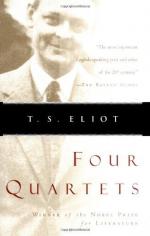
|
| Name: _________________________ | Period: ___________________ |
This test consists of 15 multiple choice questions and 5 short answer questions.
Multiple Choice Questions
1. What is desiccated when the speaker descends into a different world in the latter lines of "Burnt Norton," Part III?
(a) The world of fancy.
(b) The world of sense.
(c) The world of solitude.
(d) The world of spirit.
2. Which of the following is found at the still point of the world, as described in Part II?
(a) The heart of the world.
(b) The dance.
(c) The boar.
(d) The rose-garden.
3. What is disturbed on the bowl of rose-leaves, as mentioned in the first part of "Burnt Norton"?
(a) The bird.
(b) Memory.
(c) Dust.
(d) Time future.
4. In what form is love caught, between un-being and being, according to Part V of "Burnt Norton"?
(a) The form of passion.
(b) The form of limitation.
(c) The form of foolishness.
(d) The form of temporality.
5. By a grace of what was the speaker surrounded in "Burnt Norton," Part II?
(a) Sense.
(b) Deprivation.
(c) Thought.
(d) Incomprehensibility.
6. The speaker states, in the first part of "Burnt Norton," that what "might have been" is a(n) what?
(a) A perpetual possibility.
(b) An unrealized actuality.
(c) A frivolous thought.
(d) A passive potency.
7. Where, according to the speaker in the third part of "East Coker," do they "all go into"?
(a) The light.
(b) The dark.
(c) Art.
(d) The civil service.
8. To what agony do the "Whisper of running streams" and "The laughter in the garden" point, according to Part III of "East Coker"?
(a) Freedom and responsibility.
(b) Death and birth.
(c) Love and loss.
(d) Autumn and winter.
9. What must there not be in the way wherein one goes in order to get "there," according to the speaker of Part III of "East Coker"?
(a) Despair.
(b) Ecstasy.
(c) Faith.
(d) Doubt.
10. Words and music are said to move, in the fifth part of "Burnt Norton," only in what?
(a) Truth and falsity.
(b) The wind.
(c) Men's minds.
(d) Time.
11. In "Burnt Norton," what is daylight said to invest form with in Part III, when it is present?
(a) Suggestive permanence.
(b) Transient beauty.
(c) Affective aesthesis.
(d) Lucid stillness.
12. Above what do the speaker and his companions move in Part II of "Burnt Norton"?
(a) The moving tree.
(b) The stars.
(c) The summer leaf.
(d) The turning world.
13. What, towards the end of "Burnt Norton"'s first part, rose quietly out of the water that came from sunlight?
(a) Children.
(b) The cloud.
(c) The lotos.
(d) The bird.
14. What, in the desert of "Burnt Norton," Part V, is "most attacked by voices of temptation"?
(a) The beautiful.
(b) The soul.
(c) The man.
(d) The Word.
15. The speaker claims in Part V of "East Coker" that what "is most nearly itself / When here and now cease to matter"?
(a) Time.
(b) Man.
(c) Truth.
(d) Love.
Short Answer Questions
1. What sort of bird is in the first part of "Burnt Norton"?
2. What is happening to "the hills and the trees, the distant panorama / And the bold imposing facade" in "East Coker"'s second part?
3. Whose hidden laughter in the foliage does the speaker mention in the final lines of "Burnt Norton"?
4. What is said to be "not here" in this "twittering world" in the "Burnt Norton"'s third part?
5. The speaker states in the third part of "East Coker" that "In order to arrive at what you do not know / You must go by a way which is the way of" what?
|
This section contains 557 words (approx. 2 pages at 300 words per page) |

|




